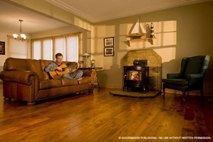Reclaimed Hardwood Flooring...
Usually Has a Story...
because reclaimed hardwood flooring used to be something else:
-timber framing
-abandoned tobacco barns
-gymnasium bleachers
-sunken timber from a river bottom.
What a great way to get a wood floor without cutting down a single tree!
Reclaimed Douglas Fir
from

Demolition of Montgomery Wards
Baltimore, Maryland
Dumpster divers can accomplish the same thing by salvaging discarded flooring,
However, most of you tell me, "Never again."
The beauty of reclaimed hardwood flooring is the nails are gone, but the joinery is not.
It is, in fact, newly milled and in tact and ready to acclimate for install.
Acclimate. Acclimate. Acclimate, some more.
Mills that sell reclaimed wood products salvage and inventory wood from all over the country, even the world,
but rarely do they have a plan for how it is going to be used. Or a time frame.
They are speculators, and gratefully so.
That means the rough salvaged material may sit in an out building for years through every season.
It may be covered, but it's not going to be kiln dried, necessarily.
You place the order. The mill fills the order. It's nifty and quick. Too quick, at times.
Slow down. When making inquiries:
Ask the following questions:
Do you own a kiln?
Can you tell me the moisture content of the material at this time?
No matter what, you or your installer should own a moisture meter and allow plenty of time for acclimation.
And don't be surprised if the floor opens up, anyway, come the first heating season.
What will the average board length be?
I'll never forget the poor woman who carefully selected her antique wood floor at a showroom before hiring me.
It was to be a handsome floor of 8 inch planks.
And, indeed, the boards were 8 inches wide, but 2 and 3 feet long!
Do you bundle the material, or is it loose?
This, of course, makes a huge difference for delivery.
Last question, do you end-match?
No, it's not a party game, funny man.
End-matching is the joinery on either end of a flooring board.
By convention, as you look down on a flooring board, if the edge facing away from you is a tongue, then the near edge is a groove.
And if that's the case, an end-matched board will have a groove in the end to the left and a tongue on the right.
That would be your end-matching.
Is it essential? No, but it does depend on how snug the side joinery is. The only way to know is to inspect other flooring produced at the mill.
No joinery in the butt ends leaves the potential for a squeak. Over level concrete, what does it matter? But if the subfloor is un-level or deflects with foot traffic,
then you may want to insist on end-matching your new reclaimed hardwood flooring and be willing to pay extra for it if that particular mill considers it to be a special order.
Return to Best Wood Flooring from Reclaimed Hardwood Flooring





New! Comments
Have your say about what you just read! Leave me a comment in the box below.